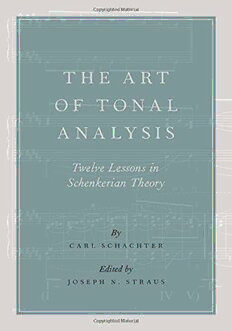
The Art of Tonal Analysis: Twelve Lessons in Schenkerian Theory PDF
Preview The Art of Tonal Analysis: Twelve Lessons in Schenkerian Theory
THE ART OF TONAL ANALYSIS THE ART OF TONAL ANALYSIS Twelve Lessons in Schenkerian Theory By Carl Schachter Edited by Joseph N. Straus 1 1 Oxford University Press is a department of the University of Oxford. It furthers the University’s objective of excellence in research, scholarship, and education by publishing worldwide. Oxford is a registered trademark of Oxford University Press in the UK and certain other countries. Published in the United States of America by Oxford University Press 198 Madison Avenue, New York, NY 10016, United States of America © Oxford University Press 2016 All rights reserved. No part of this publication may be reproduced, stored in a retrieval system, or transmitted, in any form or by any means, without the prior permission in writing of Oxford University Press, or as expressly permitted by law, by license, or under terms agreed with the appropriate reproduction rights organization. Inquiries concerning reproduction outside the scope of the above should be sent to the Rights Department, Oxford University Press, at the address above. You must not circulate this work in any other form and you must impose this same condition on any acquirer. Library of Congress Cataloging-in-Publication Data Schachter, Carl, author. The art of tonal analysis: twelve lessons in Schenkerian theory / by Carl Schachter; edited by Joseph N. Straus. pages cm Includes bibliographical references and index. ISBN 978–0–19–022739–5 (hardback: alk. paper) 1. Musical analysis. I. Straus, Joseph Nathan, editor. II. Title. MT90.S27 2016 780—dc23 2015016976 1 3 5 7 9 8 6 4 2 Printed in the United States of America on acid-free paper Contents Prelude Editor’s Preface vii Lesson One Linear Progressions and Neighbor Notes 1 Lesson Two J. S. Bach, Menuet in C minor from French Suite No. 2 and Chopin, Etude, Op. 10, No. 12 20 Lesson Three Chopin, G-minor and E-major Preludes from Op. 28 44 ♯ Lesson Four Schubert, Sonata in B major, Scherzo 68 ♭ Lesson Five Handel, Suite No. 8 for Harpsichord, Courante 89 Lesson Six J. S. Bach, Gavotte en Rondeaux from Violin Partita No. 3 in E major 103 Lesson Seven Mozart, Sonata for Violin and Piano, K. 481, Adagio 126 Lesson Eight Beethoven, String Quartet, Op. 18, No. 6, first movement 154 Lesson Nine Beethoven, String Quartet, Op. 18, No. 6, fourth movement (“La Malinconia”) 173 Lesson Ten Rhythm, Hypermeter, and Phrase 187 Lesson Eleven Haydn, Symphony No. 99, Adagio 222 Lesson Twelve Beethoven, Piano Sonata, Op. 53 (“Waldstein”), first movement 244 Postlude Q and A 273 Glossary 281 Works Cited 285 Index 289 v Prelude Editor’s Preface Carl Schachter is an extraordinary musician and musical thinker, and the world’s leading practitioner of Schenkerian theory and analysis. He has written extensively on the mas- terworks of the tonal common practice and on the analytical delights and challenges that they present. Although his articles and books have been broadly influential, and are seen by many as models of musical insight and lucid prose, perhaps his greatest impact has been felt in the classroom. At the Mannes College of Music, the Juilliard School of Music, Queens College and the Graduate Center of the City University of New York, and at special peda- gogical events around the world, he has taught generations of musical performers, compos- ers, historians, and theorists in a career that began at Mannes in 1956 and continues to the present day. In fall 2012, Schachter taught a special doctoral seminar at the CUNY Graduate Center. With more than thirty enrolled students and auditors from all the different musical disci- plines packed into our seminar room, he talked about the music and the musical issues that have concerned him most deeply. This book consists of edited transcripts of those lectures. We have smoothed out some rough edges, deleted some digressions, added some guide- posts and transitions, but apart from these relatively modest editorial interventions, this book is a faithful record of the classes. The text is accompanied by three sorts of musical examples. First, there are annotated scores. These represent the editor’s attempt to convey visually material that Schachter pre- sented and demonstrated from the piano. Second, there are short analytical reductions transcribed from the classroom blackboard. Third, there are more extended analytical reductions (Schenkerian graphs or sketches). Some of these have appeared in print before, but most appear here for the first time. In the course of his lectures, Schachter refers to a variety of secondary literature. Instead of interrupting the flow of the presentation with footnotes, references in the text are indi- cated with author/date citations in brackets, and the relevant source can be found among the Works Cited. We are grateful to the stellar editorial team at Oxford University Press, starting with Suzanne Ryan, who enthusiastically supported this project from the beginning. At an early vii viii Editor’s Preface stage, we benefitted from the incisive comments of three anonymous reviewers solicited by OUP. In the preparation of the musical examples, we had the invaluable assistance of four brilliant doctoral students at the CUNY Graduate Center: Megan Lavengood, Christina Lee, Simon Prosser, and Inés Thiebaut. Their work was supported in part by a subvention from the Society for Music Theory, for which we are grateful. Musical analysis is in many ways an ephemeral art, somewhat like musical performance in its immediacy and spontaneity. It is perhaps better suited to the classroom than to the pages of the professional or general literature. In that spirit, we hope that the twelve lessons in this book will give a vivid account of Schachter as a teacher, demonstrating for a wide audience his art of tonal analysis. Joseph Straus New York, January 2015 THE ART OF TONAL ANALYSIS
